The Classic Car Club of America is the final authority on what is a classic car and what is not. Their list spans from 1915 through 1948, and only the finest automobiles make the cut. Amazingly, reader T.J. has found for us a running and driving full classic for the asking price of $11,500. This 1941 Packard 160 coupe is for sale on craigslist out of Seattle, Washington and is a remarkably solid car for the price. With a bit of mechanical work, a new interior, and some tires you could find yourself floating down the road in one of the most desirable prewar automobiles around. The only question is if you would fix it up and enjoy it or embark on a full restoration.
To give you some idea of what this car would look like in restored condition, The Vault Classic Cars is selling a very similar model and has provided a number of pictures for us to peruse. You can see that there is a lot of potential there for our featured car to a very useable classic for tours and long-distance cruising. The 356 cubic inch inline eight-cylinder engine in this car is known for being both incredibly smooth and very powerful. This engine was rated for 160 horsepower and could be combined with an overdrive unit.
Sadly, we are not told whether this car is equipped with an overdrive unit, but the chances are good given that it was an upper end model. The ad states that there has been a large amount of mechanical work done and it runs well. It would be nice to know exactly what work has been done. However, as is the norm with free craigslist ads, it is rare to have a detailed accounting of any type.
We are also told that the car has received a new exhaust system. In the picture above we see that exhaust system and can take a more in-depth look at the underside of the car. While we do not know if this car is native to the Seattle area, there appears to be nothing more than surface rust underneath. How that happened with Seattle’s proximity to the coast and the large amount of rain the city is famous for is a mystery.
Inside is the standard good news and bad news scenario. For the good news, the car now has a brand-new headliner. The plastic on the dash is also in remarkably good shape. Early plastics like the Bakelite often seen in cars shrinks and cracks with repeated exposure to the sun. The plastic on the glovebox door and on the radio are clearly in fantastic shape. We can also see that the car is equipped with a radio, heater, and a glove box mounted clock.
The bad news is that the distinctively styled steering wheel has a number of cracks. There are businesses that specialize in restoring steering wheels only and they could certainly bring this one back to life for an exorbitant fee. The other bad news is that the interior has been exposed to moisture to the point that it is unusable. A complete interior, minus the already replaced headliner, would be a pricey undertaking if you stuck with the same level of quality the car left Detroit with.
Under the hood we see the previously mentioned Packard straight eight engine. For a car that has obviously sat for a long time, this engine looks like a good cleaning would make it presentable. Taking off the sticker on the new radiator hose would help to tidy things up a bit as well. We can also see that a clear plastic fuel filter has been added. This calls into question the cleanliness of the fuel system. The heater hoses have also been removed. This may be a sign that the heater core needs to be rebuilt, or they just haven’t gotten to replacing that hose.
Taken as a whole, this is a car to get excited about. Packards of this era were solidly built and were spectacular road cars. Fully restored, this car would be quite the prize for someone who enjoys driving older cars over long distances. Even with a new interior and a thorough going through of the mechanical parts this car would be a prize.
Would you fully restore this Packard or just get it ready for the road?
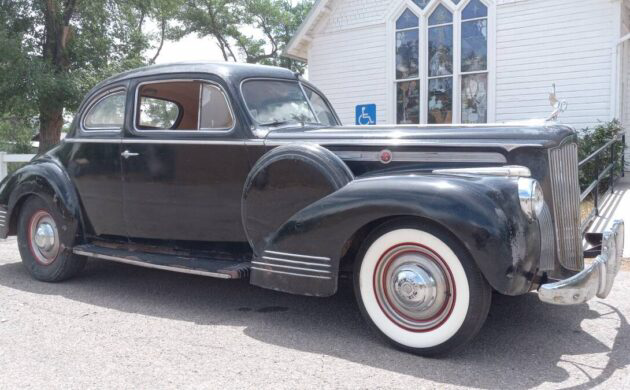
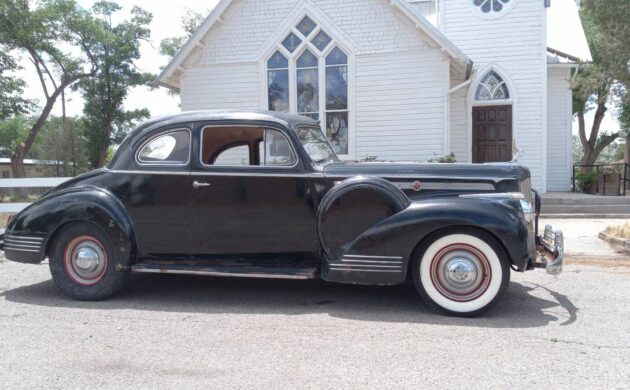

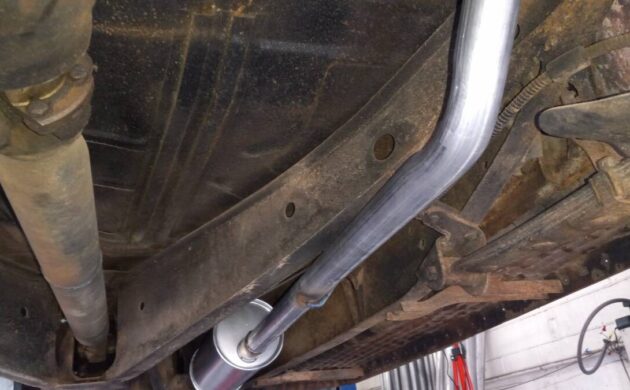
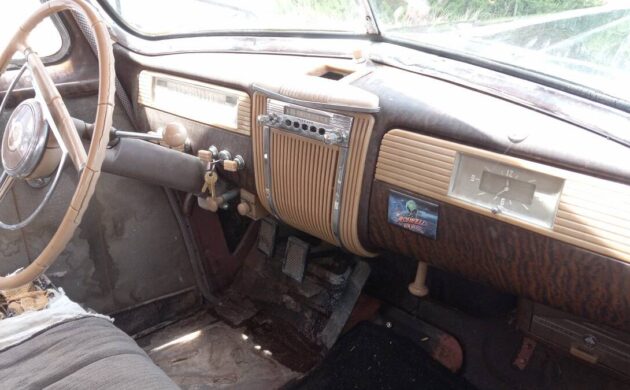
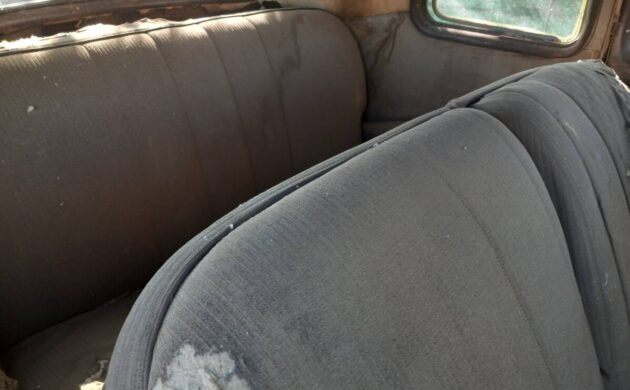



Sorry, no time to comment. I want to run right up there & buy it!
Seeyah!
Fix it up and enjoy it and some restoration if need be as long as I could keep Original appearance.
I guess Keith made it up there. It appears to be gone.
Keep us posted Keith.
Mmmmm… If I didn’t know better, the greenhouse & roofline look suspiciously like a VW Beetle! (especially the rear side windows.)
Check the boot for a 36HP aircooled “spare”!
(or, Ask a man who owns one!) LOL
Ha ha ha ha, you are so funny I almost forgot to laugh!
Old posting deleted by Seller – this posting still up…
https://sfbay.craigslist.org/sfc/cto/d/estancia-1941-packard-coupe/7522365570.html
$10,500 (New Mexico)
Jim this appears to be another of the same vintage located in New Mexico
Thanks for this. I wonder which one is a scam. I see it’s listed on several cities from San Diego to New York.
David, I don’t think it’s a scam, at least from the craigslist ad, as I’ve talked to the owner who claims he’s only the 3rd owner and has all the paperwork going back to the funeral home when new.
looks one and the same….hmmmmm
These cars are incredibly fast with the big 356 engine in a relatively small Packard–small, compared to a 180 or a limousine or big 4-door sedan.
Pete, this is incorrectly advertised, It’s NOT a 160, it’s a 120, with the small 282 eight motor. Someone has added a “One Sixty” emblem on the trunk lid, but the original craigslist ad does not claim it’s a 160.
At first glance it did look like a VW beetle conversion with one of those front ends put on it.
And it’s deleted
SF ad still up. What’s with that box taking the place of the left side mount?
Bill C.,
Glad you asked. While I have never actually seen the fender box in person, I believe I can answer your question. First, note the Packard crest in the middle of the hood side panel. Henney-Packard, the builder of Hearses & ambulances on Packard Chassis, added a chrome strip in front of that crest, on both sides. This car has those chrome strips. That means the front end came from a Henney-Packard Hearse.
Henney offered a special folding wheeled dolly assembly that on solid flat ground surfaces could be used to move the casket to/from the hearse. This folding unit was stored in it’s own space in the fender. I’ve read about them but never seen a photo of one, so I am making an educated guess here, but I’m 99% sure, especially when the special Henney-only chrome pieces are present.
The new owner should be made aware of what that is, because there are Henney-Packard hearse owners who would gladly trade a sidemount fender assembly for that left front fender!
I sent a message to the seller asking him to contact me or forward my info to the new owner, I want to ask if there are any Henney-Packard ID plates on the body, as Henney always put an ID plate on anything they created. If there are Henney plates, then the car was likely modified when new.
My theory is that the car was used by the funeral home as a “Lead car” for the procession, and carried funeral home employees to the grave site. If so, it’s very likely the ONLY Henney-Packard Super 8 180 coupe ever constructed.
Bill, I am sending you this message in regards to this post several years ago about this 1941 Packard that was a funeral car supposedly. Well the car is in NC now and for sale again. The owner sadly passed away last year and the restoration shop that had been storing it is now been told by family to sell it. The only thing I can see that was done was the seats were re-done. Other than that, not much else. It cranks right up. I think there is a new set of tires also not installed. If anyone in your group might have an interest, I can help them make contact. Thanks John G.
The term “classic” is recklesly bandied about, being misapplied to any car over 25 years old. If a car is not judged to be a classic by the CCCA, it is NOT a classic. Period! If you google the CCCA, you’ll discover how rare real classics are. This example is an exceptionally pleasing design.
For other cars over 25 years old, call them antique, vintage, veteren, historical, OLD! But the term “classic” needs to be reserved for these truly exceptional cars.
FWIW,
Allen
So ,that poor sap with a mint 1949 Packard would be shunned by the CCCA ? Who cares what they say is a classic and what isnt ? a 53 Corvette not a classic ? a 57 Tbird ? 65 Mustang ? I’d say there are a lot of cars that are classics that were built after 1948 . If you own an old car you can call it what you like, no matter what anyone else says
bone,
The arbitrary date of 1948 was selected to include all the V-12 Lincoln Continentals. As the 22nd series 1948 Packard Custom 8 cars are CCCA approved, if one had a 1949 Packard Custom 8 [with a -9 in the VIN], on application to the CCCA, I’m sure they will approve it’s inclusion. There are similar examples of other cars the CCCA deems to be eligible if they are newer than 1948, the club just considers them mostly on a car-by-car basis.
The term ‘Full Classic’ is bandied about by the CCCA to refer to their list of approved vehicles.
Merriam-Webster, however, doesn’t seem to mention the CCCA at all in the definition listings. The list of definitions and synonyms does include terms such as ‘enduring’, ‘definitive’, ‘quintessential’, and ‘a work of enduring excellence.’
CCCA approved cars certainly satisfy those definitions, but any reasonable mind would stop short of considering it an exhaustive list. Is a ‘25 T not quintessential? A ‘57 BelAir hardtop not definitive? A ‘32 Model 18 not enduring? A ‘57 Eldo Biarritz not a work of enduring excellence?
If a certain self-defined group doesn’t want my ‘54 Clipper parked near their prawns and chardonnay tent, I’m not too heartbroken that I don’t get to eat their shrimp. Cars are more fun at the Dairy Queen than siting behind velvet ropes on the putting green. How many of the aforementioned crowd could distinguish an Owen Magnetic from a pre-owned Magnavox anyway?
The side view sure looks like a VW Beetle body sandwiched between the vast fenders!
Amen Mark……………….
The CCCA can certainly choose to honor whatever cars it wishes. That said, its cutoff at 1948 may have made sense seventy years ago, but it seems like an old-fogey harrumph in 2022.
The club has no monopoly on the term “classic;” its specific definition is irrelevant outside its membership. Its designating a car a “Full Classic” does bestow significant cachet though. This lovely car may be the cheapest Full Classic around right now.
Wish that car was on the east coast and I saw it before I bought my 69 Chevelle Vert.
Its a million to one longshot , but couldn’t this coupe have been in an accident 60 or so years ago, and the front clip came off an old hearse that no one wanted ? Lots of old Caddy hearses and ambulances had their drivetrain and fenders, etc. removed for regular street cars
Don, I’ve been in touch with the owner, and he confirmed it was bought new by a funeral home, and has been this way since new. He’s only the 3rd owner, and when he was cleaning out the car and opened the fender box he found a 1941 newspaper lining the bottom of the box, and he has saved it.
Has no one yet noticed that it isn’t a 160??? It doesn’t have a 356 engine, and the interior/dashboard is obviously not 160.
Nor does it have 160 grille, nor does it have 160 taillights. If you go to the Craigslist link, the seller does not claim it to be a 160, so where did Barn Find get the idea it was a 160????
West,
Whoops, I should have looked closer as I do know the difference between a 120 and a 160! The moment I read your comment I realized the taillights, dash and entire short front end sheet metal screams 120. And of course the cheaper ribbed upholstery is from a junior eight.
I checked the original craigslist post and it makes no mention of what series Packard this is. I also sent photos to several well-known Packard & Henney-Packard experts, and not one of them caught the fact it’s a 120.
I’m far from any claim of expertise on Packards, but West – doesn’t the script on the trunk read “One Sixty”? Of course, with all the doubt cast on this car, maybe that could be wrong also.
‘ Think I ruffled a few feathers with my earlier commentary on “classics”, but then I got an education from a few of you regarding use of the term. I didn’t mean to put myself on a velvet-rope-surrounded pedestal, but If I’m placed there, I can still step down to earth. My concern is that the term gets over-used to the point where it is meaningless. You guys mention some really neat, truly exceptional cars that were built after 1948 and are not listed by CCCA – and that set me to rethinking my own view.
As I understand it, at one time CCCA only recognized pre-war cars, leaving the post-war determinations up to the Milestone Car Society, so their failure to list cars like first-year Corvettes, 1957 T-birds, 1956 Lincoln Continental Mark IIs was not intended to be a rejection, but rather an acknowledgement that post-war determinations were the province of another club.
So, if you have a ’55 Packard Carribbean Convertible, a Nash Healey, a Kaiser Darin, a Tri-five Chevy Nomad or convertible, or one of my favorites – a ’49 Cadillac series 62, you are not shunned by CCCA. Ignored maybe, but not shunned ;-).
But wait a minute… Now that CCCA has dabbled their toe in post-war waters, is it maybe a new ballgame? I don’t doubt that they may have extended their range to 1948 so they could recognize the early post-war Continentals. But for just that one car? Really? How about the Town and Country’s of the time? And by the way, my favorite T&C was the 1950 model.
I should add that I have no connection whatsoever with CCCA. As a 14 year-old kid back in the early ‘50s I read a book entitled “Classic Cars and Antiques” – ‘ believe it was a Fawcett publication. The section on Classics heavily instilled me with CCCA lore and I became a desciple. 68 years later, I still understand and sympathize with their purpose, but I realize the way I expressed my view was perhaps extreme. My apologies…
But I still object to abuse of the term “Classic” to designate any car eligible for historic licence plates. How about the ’53 Studebaker? (Let alone the ’48 Starlite Coupe, and then all the Hawks). The Dodge Viper might be a shoe-in, but how about the Pontiac Fiero? Solstice? AZTEC! ;-)? AMC Pacer? Buick Reatta? Grand National? C4 Corvette? Prowler? And these are just American examples. My wife’s ’97 LeSabre was a good car, but a “Classic”? It would now be elegible for historical plates!
I could go on and on – but I already have…
Allen,
The basic body shell was the same for the 120 and 160 club coupe, so the trunk lid interchanges. And while I’ve never checked, I suspect that the 4 holes holding the script emblem to the lid are the same, so it would be easy to “upgrade” the car to a 160.
As to the 1948 cut off date, I was not around when the decision was made, but in talking to guys who were part of the founding list [many years ago], the primary impetus to include post-war cars was from the Lincoln guys, but certainly the senior Packard guys and the Chrysler wood-bodied car guys wanted their vehicles included.
As for your interest in the 1950 T & C cars, When I was in high school in early 1969, I discovered a big barn on a local landscaping company’s farm, and inside the barn were 3 cars: 1951 Packard convertible, 1955 Roadmaster sedan with A/C, and a green 1950 Town & Country hardtop. The elderly lady saw that I really liked her cars [she bought all 3 new], and she gave them to me, with titles.
The T & C had major problems with the wood body parts due to insects, and while it was complete, the wood was basically hollowed out and I could push a screwdriver thru the body parts. One of my friends was the son of a diplomat from Portugal, and I gave him the T & C. He shipped it to Portugal where the wood work could be re-done for a fraction of what it cost in America, and as far as I know it’s still in Portugal. Somewhere I still have a photo of the T & C on my trailer, after bringing it back home.
I kept the Packard for a while and ended up selling it to a Packard club member in New England. The Buick ended up providing me all the A/C I needed for another 1955 GM car, a Cadillac 62 sedan.
Bill,
What a great story. ‘ Really enjoyed it! Thanks.